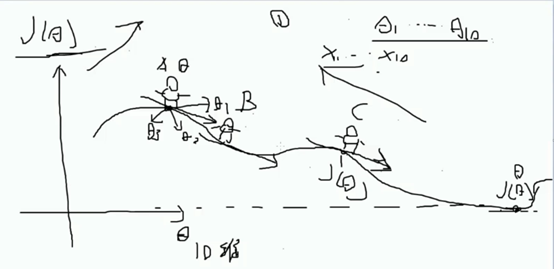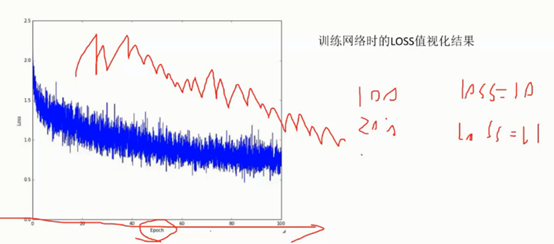1、 最优化形象解读


2、 梯度下降

学习率:

3、 反向传播






4、 神经网络

Sigmoid激活函数(已经被ReLU激活函数替代)

ReLU激活函数

最后通过代码比较下面的结果:
(数据展示结果)

代码如下:

import numpy as np import matplotlib.pyplot as plt #ubuntu 16.04 sudo pip instal matplotlib plt.rcParams['figure.figsize'] = (10.0, 8.0) # set default size of plots plt.rcParams['image.interpolation'] = 'nearest' plt.rcParams['image.cmap'] = 'gray' np.random.seed(0) N = 100 # number of points per class D = 2 # dimensionality K = 3 # number of classes X = np.zeros((N*K,D)) y = np.zeros(N*K, dtype='uint8') for j in range(K): ix = range(N*j,N*(j+1)) r = np.linspace(0.0,1,N) # radius t = np.linspace(j*4,(j+1)*4,N) + np.random.randn(N)*0.2 # theta X[ix] = np.c_[r*np.sin(t), r*np.cos(t)] y[ix] = j fig = plt.figure() plt.scatter(X[:, 0], X[:, 1], c=y, s=40, cmap=plt.cm.Spectral) plt.xlim([-1,1]) plt.ylim([-1,1]) plt.show()
(线性分类的结果)


#Train a Linear Classifier import numpy as np import matplotlib.pyplot as plt np.random.seed(0) N = 100 # number of points per class D = 2 # dimensionality K = 3 # number of classes X = np.zeros((N*K,D)) y = np.zeros(N*K, dtype='uint8') for j in range(K): ix = range(N*j,N*(j+1)) r = np.linspace(0.0,1,N) # radius t = np.linspace(j*4,(j+1)*4,N) + np.random.randn(N)*0.2 # theta X[ix] = np.c_[r*np.sin(t), r*np.cos(t)] y[ix] = j W = 0.01 * np.random.randn(D,K) b = np.zeros((1,K)) # some hyperparameters step_size = 1e-0 reg = 1e-3 # regularization strength # gradient descent loop num_examples = X.shape[0] for i in range(1000): #print X.shape # evaluate class scores, [N x K] scores = np.dot(X, W) + b #x:300*2 scores:300*3 #print scores.shape # compute the class probabilities exp_scores = np.exp(scores) probs = exp_scores / np.sum(exp_scores, axis=1, keepdims=True) # [N x K] probs:300*3 print (probs.shape) # compute the loss: average cross-entropy loss and regularization corect_logprobs = -np.log(probs[range(num_examples),y]) #corect_logprobs:300*1 print (corect_logprobs.shape) data_loss = np.sum(corect_logprobs)/num_examples reg_loss = 0.5*reg*np.sum(W*W) loss = data_loss + reg_loss if i % 100 == 0: print ("iteration %d: loss %f" % (i, loss)) # compute the gradient on scores dscores = probs dscores[range(num_examples),y] -= 1 dscores /= num_examples # backpropate the gradient to the parameters (W,b) dW = np.dot(X.T, dscores) db = np.sum(dscores, axis=0, keepdims=True) dW += reg*W # regularization gradient # perform a parameter update W += -step_size * dW b += -step_size * db scores = np.dot(X, W) + b predicted_class = np.argmax(scores, axis=1) print ('training accuracy: %.2f' % (np.mean(predicted_class == y))) h = 0.02 x_min, x_max = X[:, 0].min() - 1, X[:, 0].max() + 1 y_min, y_max = X[:, 1].min() - 1, X[:, 1].max() + 1 xx, yy = np.meshgrid(np.arange(x_min, x_max, h), np.arange(y_min, y_max, h)) Z = np.dot(np.c_[xx.ravel(), yy.ravel()], W) + b Z = np.argmax(Z, axis=1) Z = Z.reshape(xx.shape) fig = plt.figure() plt.contourf(xx, yy, Z, cmap=plt.cm.Spectral, alpha=0.8) plt.scatter(X[:, 0], X[:, 1], c=y, s=40, cmap=plt.cm.Spectral) plt.xlim(xx.min(), xx.max()) plt.ylim(yy.min(), yy.max()) plt.show()
(神经网络分类的结果)


import numpy as np import matplotlib.pyplot as plt np.random.seed(0) N = 100 # number of points per class D = 2 # dimensionality K = 3 # number of classes X = np.zeros((N*K,D)) y = np.zeros(N*K, dtype='uint8') for j in range(K): ix = range(N*j,N*(j+1)) r = np.linspace(0.0,1,N) # radius t = np.linspace(j*4,(j+1)*4,N) + np.random.randn(N)*0.2 # theta X[ix] = np.c_[r*np.sin(t), r*np.cos(t)] y[ix] = j h = 100 # size of hidden layer W = 0.01 * np.random.randn(D,h)# x:300*2 2*100 b = np.zeros((1,h)) W2 = 0.01 * np.random.randn(h,K) b2 = np.zeros((1,K)) # some hyperparameters step_size = 1e-0 reg = 1e-3 # regularization strength # gradient descent loop num_examples = X.shape[0] for i in range(2000): # evaluate class scores, [N x K] hidden_layer = np.maximum(0, np.dot(X, W) + b) # note, ReLU activation hidden_layer:300*100 #print hidden_layer.shape scores = np.dot(hidden_layer, W2) + b2 #scores:300*3 #print scores.shape # compute the class probabilities exp_scores = np.exp(scores) probs = exp_scores / np.sum(exp_scores, axis=1, keepdims=True) # [N x K] #print probs.shape # compute the loss: average cross-entropy loss and regularization corect_logprobs = -np.log(probs[range(num_examples),y]) data_loss = np.sum(corect_logprobs)/num_examples reg_loss = 0.5*reg*np.sum(W*W) + 0.5*reg*np.sum(W2*W2) loss = data_loss + reg_loss if i % 100 == 0: print ("iteration %d: loss %f" % (i, loss)) # compute the gradient on scores dscores = probs dscores[range(num_examples),y] -= 1 dscores /= num_examples # backpropate the gradient to the parameters # first backprop into parameters W2 and b2 dW2 = np.dot(hidden_layer.T, dscores) db2 = np.sum(dscores, axis=0, keepdims=True) # next backprop into hidden layer dhidden = np.dot(dscores, W2.T) # backprop the ReLU non-linearity dhidden[hidden_layer <= 0] = 0 # finally into W,b dW = np.dot(X.T, dhidden) db = np.sum(dhidden, axis=0, keepdims=True) # add regularization gradient contribution dW2 += reg * W2 dW += reg * W # perform a parameter update W += -step_size * dW b += -step_size * db W2 += -step_size * dW2 b2 += -step_size * db2 hidden_layer = np.maximum(0, np.dot(X, W) + b) scores = np.dot(hidden_layer, W2) + b2 predicted_class = np.argmax(scores, axis=1) print ('training accuracy: %.2f' % (np.mean(predicted_class == y))) h = 0.02 x_min, x_max = X[:, 0].min() - 1, X[:, 0].max() + 1 y_min, y_max = X[:, 1].min() - 1, X[:, 1].max() + 1 xx, yy = np.meshgrid(np.arange(x_min, x_max, h), np.arange(y_min, y_max, h)) Z = np.dot(np.maximum(0, np.dot(np.c_[xx.ravel(), yy.ravel()], W) + b), W2) + b2 Z = np.argmax(Z, axis=1) Z = Z.reshape(xx.shape) fig = plt.figure() plt.contourf(xx, yy, Z, cmap=plt.cm.Spectral, alpha=0.8) plt.scatter(X[:, 0], X[:, 1], c=y, s=40, cmap=plt.cm.Spectral) plt.xlim(xx.min(), xx.max()) plt.ylim(yy.min(), yy.max()) plt.show()
